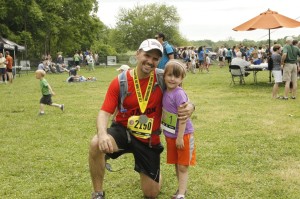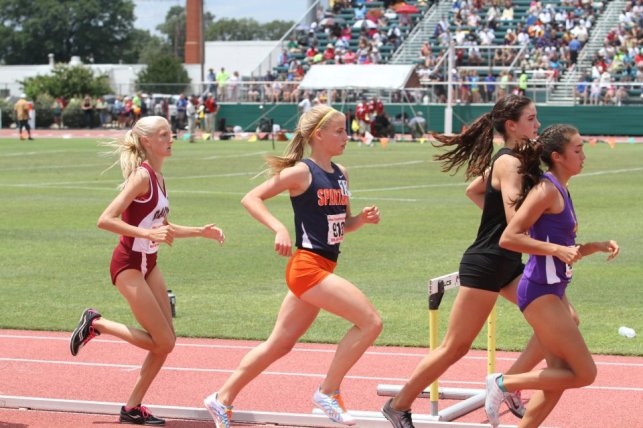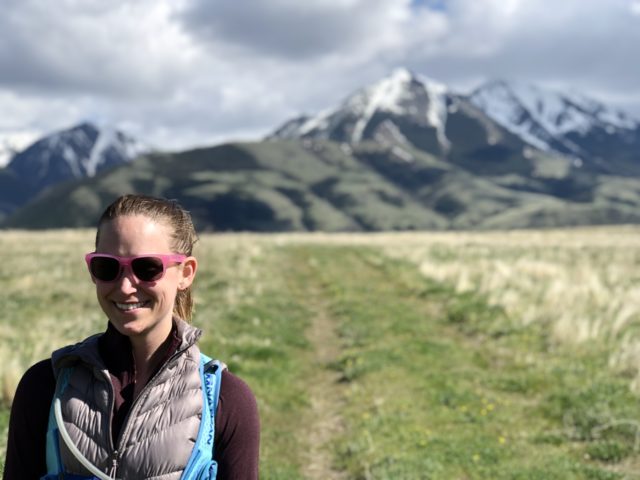
Through the throngs of spectators lining the Marine Corps Marathon course, Marine Maj. Anthony Garofano will have his ears open. Underneath the canopy of cheers, he’ll listen for an unmistakable sound.
“At certain points, she’ll be out there and, if she’s crying, she’ll be easy to hear,” Garofano said of his newborn daughter, Helen.
While training for his first marathon, Garofano fit in runs around a demanding schedule as an active duty judge advocate general for the Marine Corps, his commitment to organize a running club for Capitol Hill staffers and preparing to be a new dad.
In spite of all that, everything went pretty smoothly, thanks to his understanding wife, Christine, and co-workers.
“My office has been incredibly supportive the whole time and there’s only one run that I went on with my cell phone in my hand just in case I needed to stop early,” he said. “Otherwise it’s been very smooth. My runs are early enough that Chris doesn’t even know I’m going.”
Garofano was commissioned as a Marine Corps officer in 2004 and began serving as an active-duty service member in 2008. Through his job, Garofano ended up in charge of the Capitol Hill Running Club this year. During training season for the Marine Corps Marathon, the Marine Corps liaison office organizes the club, setting up a training plan for the race, water stops and support for the weekly long runs. Since he was coordinating training for a group of 20 to 30 Hill staffers, he figured this would be a good year to tackle the marathon himself.
“It was sort of in the back of my head — I don’t want to, but I (also do) want to run a marathon — so taking on this club was the opportunity,” he said.
The group meets Tuesday and Thursday mornings, with a long run on Saturdays.
“That doesn’t interfere with work schedule, but it ruins your Friday night a little bit,” he said. “(But) when you’re 32 and you have a baby, there’s not much Friday night left to ruin.”
Luckily, his wife understands the demands of both the club and marathon training.
“I’m really lucky to have a wife who’s so understanding about the commitment to the running and the club and who’s healthy enough to not have an issue,” he said. “This could be a lot more difficult without people being supportive.”
In addition to his time working as a fellow for Rep. Darrell Issa (R-Calif.), whose district includes Marine base Camp Pendleton, Garofano has also served as a military prosecutor and a battalion judge advocate who deployed with the 1st Light Armored Reconnaissance Battalion to southern Helmand Province, Afghanistan in 2010. While overseas, he helped the troops handle legal matters, like rules of engagement or dealing with detainees. Now, he works in the Marine Corps House liaison office, educating and informing members of Congress about the Marine Corps.
He’s had some training interruptions —missing his 18.5-mile long run the day his wife went into labor in late August, and a week to adjust to Helen’s sleeping schedule. He had to miss a few runs when traveling where it was unsafe to run, but wasn’t worried about it affecting his overall training. The weeks he’s had to miss long runs, he said he’s felt just as strong going farther the next week.
“If I missed several weeks in a row, then I’d be concerned, but missing one or two long runs doesn’t fill me with terror,” he said. “Maybe that’s ignorance.”
His travels have given him a few unforgettable runs all around the world. One of his favorites was during a trip to Guam, where he got to run along the beach. And another run in Hanoi, Vietnam, which was so humid that his watch face fogged up as soon as he stepped out of his hotel.
“It was about 6:30 in the morning; it was like the entire city was outside exercising, whether it be Tai Chi or playing badminton, or there was a muscle beach set up, with guys doing bench press and sit ups,” he said. “It was really cool to see so many people outside exercising at the same time, it was a neat community spirit thing.”
Garofano has spent years running, but is tackling long distances for the first time. He was a sprinter at Middlebury College in Vermont. Since then, he’s mostly lifted weights, gone on multi-day hikes and run just enough to pass the annual physical fitness test for the Marines.
“Every year the Marine Corps makes you run three miles to make sure you’re still in shape; that was the standard for me prior to this year,” he said.
As a result, every week’s long run is a new milestone as the farthest he’s ever run in his life.
“A lot of it has been mental,” he said. “I’ve gotten to the point if I can do 17.5 miles, I figure as long as I can keep it up I can suffer through 26.”Although Garofano has managed to fit almost everything into his weeks, one thing that has suffered has been spending time with friends, though he said they’re all understanding of the time spent running and with his new daughter.
“My friends and Chris’ friends may think we’ve abandoned them, but I think we’ve got a pretty good excuse,” he said. “The combination of running and baby has certainly reduced the amount of going out to dinner, but everyone understands.”
This article originally appeared in the November/December 2014 RunWashington.
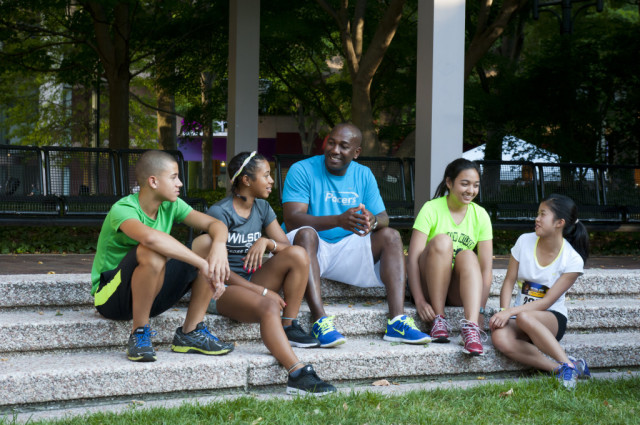
While many coaches are worried about their team bringing home championships, Desmond Dunham his eye on a bigger prize.
The cross country coach at Wilson High School in Washington D.C. (now at St. John’s College High School, also in D.C.), who has been coaching for 17 years, said he measures his accomplishments by the success his athletes have later in life, once they’ve put their running shoes away.
“The true measuring stick for me is what has my program done for the kids over time: when they go to college, they go in their careers, they have their family,” he said.
Dunham, who coaches the girls cross country team as well as the co-ed track team, takes a holistic approach to coaching, focusing as much on their emotional well-being and academic performance as their achievements on the track. One of his favorite parts of coaching is to see how his athletes are able to carry the lessons learned in running over to other parts of their life.
“You have to learn to give your best even when you don’t feel your best. My athletes often hear me say you have to be willing to give 100 percent even when you don’t feel 100 percent,” he said. “I try to get them to realize that applies to everything you do in life.”
Hear Desmond Dunham on an August 2019 appearance on Pace the Nation
Marika Walker, a second-year PhD student in kinesiology at the University of Georgia, said the discipline she learned on Dunham’s cross country and track teams from 2004 through 2007 has gone on to help her in other aspects of her life.
“Running with him was difficult, and we achieved lot of stuff I wouldn’t have imagined before I started,” she said. “Now looking at other things, I can do a lot more than I think I can. I put more effort into all the other things that I do.”
Walker also gained some more concrete benefits from her running career on Dunham’s team: a scholarship to North Carolina State for her undergraduate education.
“Track got me through college, basically to where I am today,” she said. “I don’t know where I would’ve gone to school if I hadn’t have run for coach Dunham.”
While Walker no longer runs competitively, she continues to workout and maintain an active lifestyle.
Other athletes have benefited from Dunham’s holistic training more immediately. Despite being the new kid at school in August 2013, Julie Rakas, now a junior at Wilson, said being a member of the team made her feel right at home.
“I joined cross country when I first came here and he really made me feel included,” she said. “He really makes the whole team feel like a family almost.”
She said Dunham makes sure athletes are doing well academically, giving time off from practice to get caught up on work or visit teachers and getting permission before taking kids out of class for a competition. She also said he’s there emotionally for his athletes.
“He’s always there to talk to us. I’ve come to him with a lot of personal problems and he offers really good insight,” she said. “I feel really comfortable with him and I completely trust him.”
Dunham has overcome some of his own hurdles as well. He grew up in Gary, Ind., which he calls the “murder capital” of the country at the time. It was his own cross country coach who made sure Dunham and the other athletes learned the value of hard work and discipline – a coaching style he tries to emulate today.
“He was a father to many of us, the guys on the team,” he said. “We were able to just overcome a lot of adversities that we were facing in Gary, from the educational system to the violence, and he made running our outlet. He held us accountable no matter what the circumstances were, no matter what our backgrounds were.”
When Dunham moved to D.C. to attend Howard University, he volunteered with a local running program before getting a gig coaching for St. Gabriel’s Catholic School while working on his master’s. He coached at Eleanor Roosevelt High School in Greenbelt and the University of Maryland, in addition to coaching a junior olympic running team, before taking a job at Woodrow Wilson High School in 2012.
“The ability for me to be able to put a smile on a child’s face through the sport of cross country and track and field, it was the most rewarding experience that I had as a person,” he said. “I’ve always felt like after my first year of coaching that it was not only my passion but I also had a purpose in it as well.”
Dunham was so devoted to his athletes that he and his wife dipped into their own bank account to ensure all athletes on his junior olympics team, regardless of their economic background, could participate and travel with the team.
“We used to give all of our money to making sure kids could travel and have the same experience as everyone else,” he said. “There was a time when our utilities were being cut off so we could make sure we gave every single kid in our program the same experiences.”
In addition to coaching, running all three seasons and working full-time as a physical education teacher at Wilson, Dunham also coaches his own two kids in a variety of sports from baseball to basketball to tennis. He also is a board member at Capital City Little League.
“Somehow we manage everything,” he said, noting that he couldn’t do it without his “awesome wife.” “We try to keep a balance where we make sure if we do have busy weeks, we try to culminate the week making sure there’s a focus on our kids to make sure we’re still in tune with them.”
On top of everything, Dunham is involved with the D.C. Cross Country Project, an initiative with Pacers to increase participation across the city, improve programs at schools and increase awareness of the sport. He said he is excited to be part of an organization that lets him help even more young athletes succeed.
“I could do great things within my program to help a good amount of kids, but if I can be involved with something on a much larger scale, it’s definitely way more fulfilling to be able to help the masses to be able to have the experiences I once had,” he said.
Dunham still manages to find time to log about 30 to 40 miles a week, as much for the physical benefit as the emotional release.
“After finishing a run,” he said, “I feel like I shed so many pounds of stress.”
This article originally appeared in the September/October 2014 RunWashington.
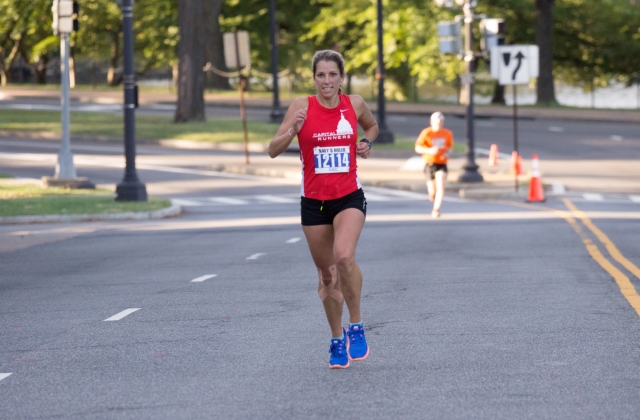
Many runner notched new personal records – and broke some course records as well – on a beautiful morning at the Navy-Air Force Half Marathon.
[button-red url=”http://www.zippyraceresults.com/search.php?ID=4284″ target=”_self” position=”left”] Half Marathon Results [/button-red]Erin Taylor, who runs with Capital Area Runners, had hoped to finish in the top three, but ended up winning the half marathon for the women in 1:20:36, getting a new PR and breaking the course record, despite running much of the course on her own.
“[button-red url=”http://www.zippyraceresults.com/search.php?ID=4285″ target=”_self” position=”left”] Five Mile Results [/button-red]I tried to go out with two guys on my team, which I did for about a mile and a half, but then I just thought, they’re going out too fast for me. So I literally did run the entire race by myself, which is probably why I’m most happy about my time,” the Arlington resident said. “That was a little rough, I really wasn’t with anyone.”
Taylor is training for the Marine Corps Marathon at the end of October, and said she hopes to be able to tuck in with some other women and not spend any of the race by herself.
The half marathon course begins by the Washington Monument and goes along the mall before about a two mile out-and-back on the Rock Creek Parkway. After crossing the Memorial Bridge, runners retrace their steps into the city and make a loop around Hains Point before finishing at the monument again.
For Taylor, the best part was the run in Rock Creek Park.
“I thought I would hate it because it’s the big hill, but it’s actually really beautiful there, it made it really nice,” she said.
Patrick Fernandez, also from Capital Area Runners, took the top spot in the men’s half marathon in 1:07:54, just two seconds slower than the course record he set last year.
“We were really in a big pack for the first half of the race, then mile six or seven, coming right out of Rock Creek when it started to flatten out is when I made my move,” Fernandez said. “From there I was kind of running by myself. I had to run my own race.”
The active duty Coast Guardsman used Sunday’s race as a physical and mental tune up for next month’s Eindhoven Marathon in the Netherlands, where he’ll race with the armed forces marathon team.
“This is actually my first internal race,” Fernandez said. “Based on how I did at the Marine Corps Marathon last year, I was lucky enough to get selected to compete with the team this year in the Netherlands.”
Both the male and female top masters finishers also set new course records.
Thomas Adam, who runs for Ragged Mountain Racing in Charlottesville and won the 5 miler, said he planned to stick with a members of the Georgetown Running Club at the start, but slowly pulled away in about the last mile.
A highlight of the course for Adam for the loop around Hains Point, though other runners said they were bored during the three mile loop.
“It’s kind of relaxing and calming being on that loop because it’s quiet, you’re near the water, it’s a beautiful day. So I just tried to focus on staying relaxed,” he said.
Following his win on Sunday, Adam will be back in D.C. for the Army Ten-Miler in early October and is also training for the Indianapolis Monumental Half Marathon in November.
Maura Carroll, who runs for the Georgetown Running Club, won the 5 miler for the women in about 30 minutes. While she was happy with her time, she said she wished there have been more people with her during the race to pull her along a bit faster.
“I was expecting there to be a few more people who were running around the pace I was,” she said. “After the first mile or so, I was pretty much alone, so that was kind of hard through Hains Point. Just hard to stay focused and it was kind of windy.”
Carroll was one of the people who missed the early start of the 5 miler in 2013, but said everything went smoothly at this year’s start.
“I was glad it started on time this year, I missed the start last year, so that was not great,” she said. “It was a lot less stressful.”
Her next race will be a 10k in Pittsburgh later this month, then the Army Ten-Miler in October.
Jeff Lewis, an Army veteran who competed in the wheelchair division, said when he stopped peddling a few times during the race, he realized that his muscles were tightening up in the cold. That motivation to keep peddling – as well as staying focused on the police motorcycle ahead of him – enabled him to win the 5 mile wheelchair division.
Lewis was racing in honor of Private First Class Adam Marion, who he served with in Iraq.
“He lost his life April 28, 2008,” Lewis said. “He was taken out by mortar rounds. A young, bright kid, a lot going for him. Just taken out of the game way too early.”
Nathan Nudelman, the coach of the Naval Academy Marathon Team, brought 19 students to the race from Annapolis for their last tune up before they end the season at the Steamtown Marathon in Pennsylvania in October.
One of them, Greg Marshall, a senior at the Naval Academy, ran the five mile race Sunday as part of the taper for the upcoming marathon. While the schedule at the academy is demanding, Marshall said it’s not a burden to fit in a run at the end of a long day.
“I kind of needed it. It’s great to go to school all day and have that stress you out, then hang out with some of my best friends, get a good run in. It’s definitely a good escape,” he said.
After the race, Adm. James Winnefeld, the vice chairman of the joint chiefs of staff, who ran the half marathon, spoke with the Naval Academy students about his 36-year career in the Navy and as a runner.
“It’s really humbling,” Marshall said. “To see that he took the example same path I did and is still running half marathons is pretty inspiring. It’s definitely a good person to emulate I think as I go into my career. I have no clue if I’ll be in for 36 years but until I hit that mark, I probably shouldn’t stop running because he didn’t.”
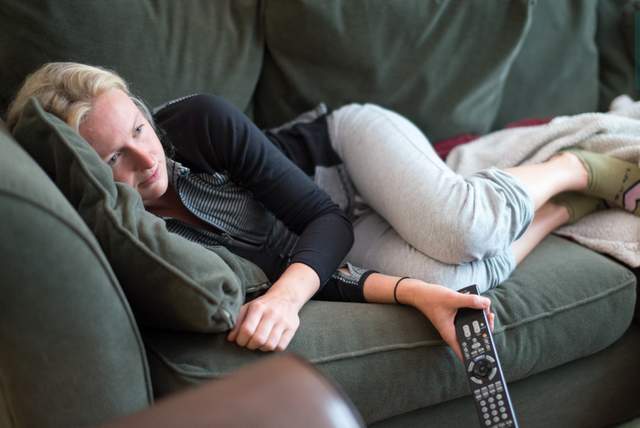
Some Boston Marathon hopefuls had to deal with heartbreak long before they reached the eponymous hill in Newton.
While Boston always carries a special significance, runners this year were even more determined to prove the running community’s resilience after two bombs went off at the finish line in 2013. Some, however, were sidelined by injury after months of training and anticipation for what they expected to be one of the most emotional and memorable marathons of their lifetime.
“It wasn’t until I signed up and was registered that I started to really feel the impact of how special an opportunity it would be to run this year with everything that has happened and just how emotional and special it’d be this year,” said Phoebe Markle, an Alexandrian who was set for her first Boston. “To be a part of that, I don’t take that for granted.”
She made it through 13 weeks of training when she ran a 22-mile long run a little too fast and felt some pain in her calf. She tried to push through, not wanting to miss out on training so close to the race. But eventually, she had to confront the reality that she may not be able to run. She went to the doctor and the problem was diagnosed as a strained calf.
Whether she would run was up in the air until just a few days before the race, when her physical therapist told her not to run, worried it could be a stress fracture. Discouraged, she felt like all the hours and miles logged were for nothing.
“That was my priority, training through the winter. I got in every workout through the polar vortex, in the ice, wind, snow,” she said.
She has already qualified for the 2015 Boston Marathon and said she will try again then and “train smarter.”
With plans to drive to Massachusetts with her boyfriend and stay with friends, Markle was, financially, just out her entry fee. Others weren’t so lucky and had far less flexible travel plans. When Emory Ford of Kensington got hurt about a month before the marathon, he forfeited his entry fee and the cost of his travel plans and hotel for the weekend.
“It was an expensive choice to not run and to cancel my plans,” he said.
Ford was skiing with his son in West Virginia when he landed wrong and injured his back.
“Something I probably shouldn’t have done — a ski jump,” he said. “I landed on my back. I’ve been having issues with my sciatic nerve, it’s hard to stand up and sit down and it causes my calf muscles to tense on the left side.”
He wasn’t able to run at all with the injury and realized he would not be able to do the marathon, though he said he’ll likely try to run it next year.
“It’s too bad I couldn’t go this year, though, because I’m sure it’s going to be extra special,” he said.
For Mike Gorfinkle, running Boston this year was about finishing what he started in 2013. He ran for a charity in honor of his cousin who died of cancer and was about half a mile from the finish line when the the bombs went off. Now an Ellicott City resident, he grew up in Boston watching the race, and was one of 5,000 runners who couldn’t finish last year and was invited back in 2014, but ran into trouble when he strained his Achilles tendon playing with his daughter after a long run.
“Any other race, I would just wait for the next one and get better,” he said. “But for this race, I’m not by any means a professional athlete, but it’s like playing in a big game.”
His doctor told him that under any other circumstances, he would advise Gorfinkle not to run, but that he understood this was a “once-in-a-lifetime” race. Determined to run the race, Gorfinkle abandoned his sub-four hour goal and planned on taking walking breaks every two miles.
“I figured I’ll run as far as I can until I can’t anymore, and then I’ll drop off at a medical tent,” he said before the marathon. “Normally when I run races, there’s some competition to it, but for this race, it’s more about being there for the day and celebrating and remembering what happened last year.”
Gorfinkle finished the marathon in 5:46. He said it was very difficult to run through his injury and even had to stop at a medical tent along the course to ice his Achilles tendon for about 20 minutes.
“But I made it,” he said.
Arlington’s Daryle Lademan also managed to cross the finish line in Boston, despite battling injuries for almost three months. In February, she was out of training for about three weeks with shingles, then just a few weeks later, starting having pain in her IT band. Though her coach didn’t approve, she made a last-minute decision to run, “because it was Boston.”
While she initially just flew in to pick up her number and maybe run the B.A.A. 5k two days before, she ended up on the bus to the starting line in Hopkinton the morning of the marathon.
“I had a $20 bill in my sports bra. I figured, worst case, I pop out at the halfway point and take the T back to Boston,” she said. “I got to the halfway point and (her IT band) was doing alright; it probably was adrenaline. I just sucked it up and went all the way to Boston.”
In addition to wanting to participate in this year’s marathon to take back the finish line, Lademan had the added motivation of having to pull out of last year’s marathon two weeks before the race with another injury.
“I thought ‘No, damnit, I’m not sitting this one out,’” she said. “I was bound and determined to pull out all the stops to make it happen it year.”
She went out without a time goal and ended up finishing in 3:42 – not a personal best time by any means, though it was definitely a personal best race experience.
“It was absolutely the hardest race, but also the most life-affirming race I’ve ever run,” she said. “The thought that I might have not run it, or might not have given it a try because I wasn’t well trained, or I wasn’t going to PR, my heart just breaks thinking about that because I would’ve missed out on the best running experience of my life.”
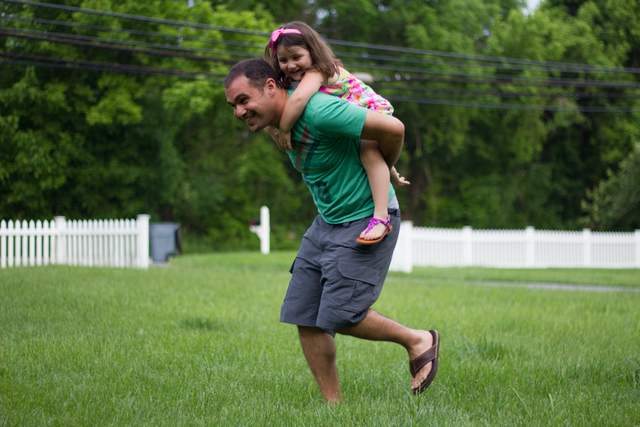
This story originally appeared in the July/August 2014 RunWashington.
Nikeya Green – Fairfax
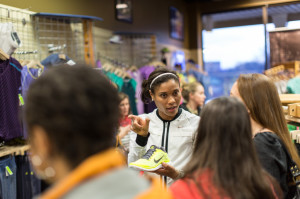
Photo:Dustin Whitlow
Nikeya Green began running when she was just 5, tagging along on her father’s runs to get in shape for his Army physical fitness tests.
“Whenever he would train to get in shape, he would take me out for some of his runs,” she said. “I used to have a bad habit of wanting to start out at a full-out sprint and then I’d be tired, but my dad taught me how to pace myself.”
Green continued running and joined the track team at Hayfield High School in Alexandria. She went on to run in college at
Wake Forest, then ran professionally for six years, during which she followed a regimented training schedule. The Fairfax County resident now works as a running specialty rep for Nike and says her training has taken a backseat to her job, though she is working to get back into more regular training and find a way to balance work and fitness.
“I laugh; that’s my fitness schedule right now,” she said. “When I made the transition, started working for Nike in 2011, that became my priority, and I put running on the back burner … I’ve done things that keep me accountable throughout the year, but in general I don’t have a locked in training schedule now.”
Courtenay Brinckerhoff – Alexandria
After Courtenay Brinckerhoff logs miles on the road, she heads online and logs her achievements on her running blog, “Running with Perseverance.”
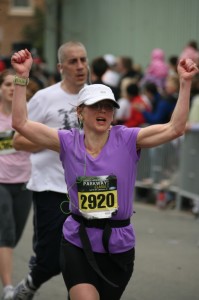
RunWashington Photo: Courtesy of Brinckerhoff
She started running in 2001 to lose weight after spending a lot of sedentary time in college and law school. Like many people, once she started, she got hooked for all the other benefits, like getting outside, exploring cities on vacation and meeting friends through running groups, she said. When she first started, Brinckerhoff struggled with injuries from doing too much too soon while training for her first Army Ten-Miler.
“I did it all wrong,” she said. “I figured since I did an exercise class for an hour, I could run for an hour, so I just ran. I ended up with a bad injury, I could barely walk.”
Her other advice for beginners is to find a good pair of running shoes that fits your foot type. She started her blog more than three years ago as a way to stay motivated during training.
“Part of it was personal accountability, even if only a handful of people are reading my blog,” she said. “As I continued blogging and met more people in this blogging community, you hear about other people doing things, try things you wouldn’t have tried on your own. You inspire each other to try new things.”
Her blog, available at Got2Run4Me.com, gets about 10,000 hits a month. She writes race recaps, product reviews and recipes in addition to logging her workouts.
Cedric Cherry – Silver Spring
Cedric Cherry started running in 2011 to lose some weight and could barely run for 10 minutes without stopping on his
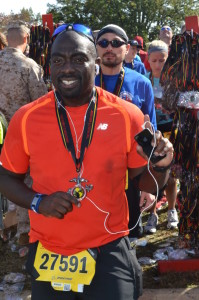
Photo: MarathonFoto
first try. Forty seven pounds, three marathons and a triathlon later, it’s about way more than fitness for him.
“It’s an awesome feeling to conquer that, especially as an adult,” he said. “You feel like a kid again.”
When he first started, he said he had a lot of questions and no one to turn to for answers. His wife looked to the Internet and suggested he try a run-walk-run method, which helped him build up his stamina. Even as he was improving, other runners flew by him on the running paths. He learned, however, that running isn’t about drawing comparisons to others.
“Do it for you, don’t do it for other people,” he said. “Don’t worry about what other people can do, you’re in a race against yourself. Don’t try to race other people, just work within you. It just all came together for me.”
Cherry ran the Marine Corps Marathon 10k the same year he started running, and after his first race experience, he was totally hooked and felt he could officially call himself a runner.
“I think when you get into that first race and you’re around all these people – short, tall, skinny, slow, fast — and you’re like, ‘this is awesome,'” he said. “I think that first race kind of clicked for me.”
Following that race, he told his wife he wanted to finish a half marathon, which he did just a few months later in December. At the finish line of the half, he had a goal to finish a marathon, and crossed the finish of the Flying Pig Marathon in Cincinnati, Ohio in 2012. He’s also run two Marine Corps Marathons, most recently in 2013. Since then, running has led to more accomplishments and crushing more goals. Cherry learned how to swim as an adult and completed his first triathlon earlier this year. He’s aiming for a half ironman next year.
“I think getting started is the hardest thing,” he said. “The whole saying goes, ‘It’s not how you start, it’s how you finish.’ I actually believe it’s how you start, you just have to start. Starting is winning, once you start it you’ve won because with me I feel healthier … I would tell people be yourself and have fun.”
Katie Sheedy – Washington
Katie Sheedy first turned to running on the indoor track team as a way to stay in shape during the off-season in high school. The soccer player, however, soon started to love running as a sport in its own right.
“I started out as a sprinter, which is funny now because it seems like every year I ran I got longer and longer and now I do marathons,” she said. “I ended up really falling in love with the sport itself; it definitely was so much more than keeping in shape.”
While she first gravitated to speed workouts, Sheedy grew to enjoy catching up with friends during longer runs in high school. The Logan Circle resident now shares her runs with the greater D.C.-area running community and trains with the Capital Area Runners a few times a week. The former sprinter became a bona fide distance runner with a 2:52:52 at the 2013 Chicago Marathon. She also volunteers with Teens Run DC, an organization that pairs middle and high school students with adult mentors for a weekly run on Saturdays. The students also train during the week with teachers.
“We use running as a vehicle to help them set goals for themselves and feel positively about certain aspects of their lives,” she said. “It’s fun seeing how they grow as young adults and also as runners. A lot of them don’t enjoy the running aspect when they first join the program, but some of the kids can run pretty competitively in their age group. It’s really exciting to see them feel proud of themselves and excited about running.”
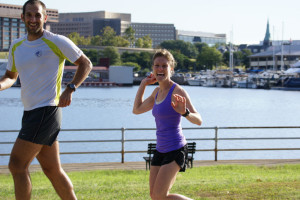
Jason Levine – Washington
For Capitol Hill Classic race director Jason Levine, running is and always has been a family affair. He began running in 2009 as a way to get in shape and spend time with his daughter, then only a year old.
“I was overweight and I recognized that I had fallen out of shape and I decided to do something that could involve my
Jason Levine with his daughter Annabelle at the North Face Endurance Challenge. Photo: Shannon Culbertson
kid. As luck would have it within a day of that revelation someone on a parenting listserv wanted to give away a jogging stroller. I’d never run before in my life, but thought I can try to do this,” he said. “I’d go out two or three times a week in the morning, she’d wave happily at all the people out exercising in the morning and it got to be fun.”
Four years later, Levine has been “bitten by the bug” and completed marathons and 200-mile relays with friends. His daughter, 5, has also run several fun runs. He struggled with injuries when he first started, going out too hard and too fast as an inexperienced runner. He also had a hard time finding the time to log miles and balance his job and family time with running.
Though he regularly runs about 25 miles per week and organizes the Capitol Hill Classic 10k, which benefits his daughter’s school, there are days when Levine still wonders if he can really call himself a runner.
“You look out there on the roads and say that person is going out seven days a week, running seven-minute miles, you think, ‘How do I compare to that person?'” he said.
It was the running community, however, that made him feel like he’d earned the title during his first year in the sport.
“When I was going out there, I was paying attention to other runners: they were acknowledging me and I them; it just clicked that, yeah, I’m part of this running community,” he said. “Anybody who goes out there and puts one foot in front of another is a runner.”
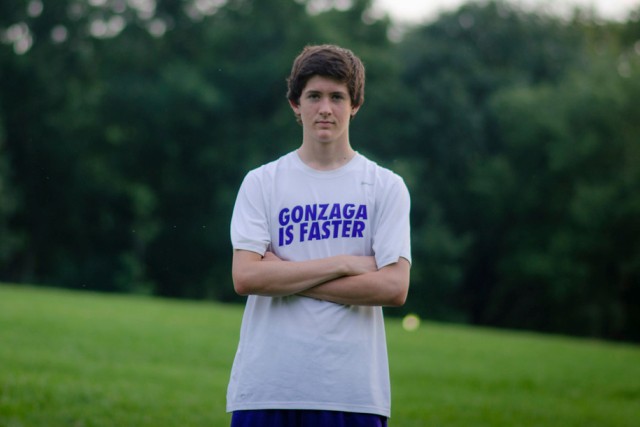
Chris Hoyle, a senior who runs for Gonzaga College High School in Washington, is a team captain who leads by example.
In addition to being the top runner on the team this year, the Oak Hill, Va., resident mentors younger runners, calling them during schools breaks to make sure they’re staying in shape, and tries to create the same inclusive atmosphere he found on the team when he joined as a freshman.
“He doesn’t talk a lot, but he goes out there and gets the job done and the other kids can see he’s 100 percent serious about running all the time,” said John Ausema, the head coach of the cross country team. “Every little part about being a good runner that some kids might ignore or skimp on and think nobody’s watching, he’s the guy who does all [button-red url=”http://www.runwashington.com/2013/12/16/runwashington-high-school-cross-country-team/” target=”_self” position=”left”] More of the All-RunWashington team [/button-red]those things and makes sure he’s 100 percent ready to have his best race.”
After beginning the season with an extended case of bronchitis, Hoyle bounced back and finished third in the private schools championship and made the all-regional team at the Nike Regional Championship.
“There was a little bit of adversity in there. I guess he had an extended case of bronchitis in most of September and had trouble breathing,” Ausema said. “He was still actually running pretty well, most people probably weren’t even aware he was sick. He ended up being our top runner in almost every race.”
Hoyle will graduate from Gonzaga in June and plans to continue running next year at the College of William and Mary in Williamsburg, Va.
Hoyle did not run competitively before high school, but his parents encouraged him to go out for the cross country team as a freshman after he enjoyed a local 5k race. He served as one of the team captains this year, something he’s aspired to ever since joining the team as a freshman.
“I really enjoyed that because I remember looking up to the captains when I was a freshman, I always looked forward to becoming one,” he said. “We just helped encourage the kids to get out there. Even in the off season, we’d be calling kids up to see what miles they’ve run each week, and that’s been a lot of fun.”
He remains involved in athletics and youth mentoring even in his spare time. This summer, he volunteered at the Reston Kid’s Triathlon.
Despite spending about 25 hours a week with the cross country team, the student athlete also has to find time for school work, especially in economics, his favorite subject that he hopes to pursue in college. He is also part of the investment club and raises money for the medical missionary club through clothing drives and selling t-shirts.
“One of my friends started it last year, he just was looking for some friends to start it, and I said I’d love to do it,” Hoyle said. “We meet once a month and talk about what to do with our money and the best way to give it to them. “
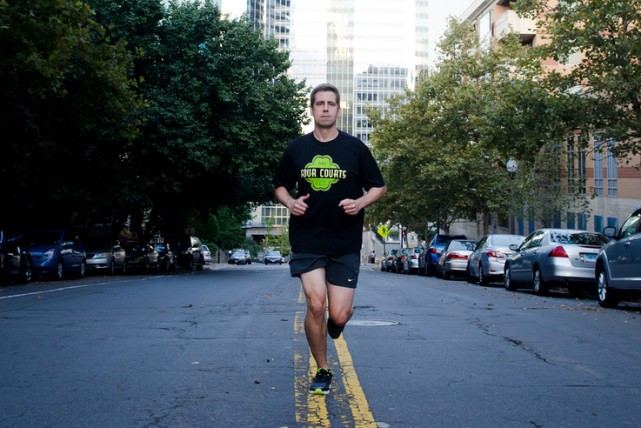
Juggling a full-time job and night classes for an MBA can be hard enough, but somehow Scott Brodbeck managed to find time to train for a marathon too.
Brodbeck, who founded two hyperlocal news sites for Arlington(Arlnow.com), Bethesda (Bethesdanow.com) and Reston (Restonnow.com) generallyworks 8 to 6, but says he “never really takes a break from the day job.” He recently earned his MBA from Georgetown University, where he had class two nights a week in addition to homework. This fall, he tackled his first marathon at the Marine Corps Marathon.
“Trying to earn a graduate degree and running a business and running, there wasn’t much down time,” he said. “I did my best to fit in runs, but half the time I’d find myself running at 11 p.m., which is probably not ideal, but I’m not an early riser.”
Brodbeck, who has been running seriously for about two years, was one of thousands of non-elite runners who crossed the finish line on Oct. 27. Unlike the pros, the average runner doesn’t get to take time off from work, family responsibilities and social gatherings to train.
His advice to other first time marathoners on how to fit it all into just 24 hours is to enjoy it and pay attention to signs in your body that could signal an injury coming on.
“I think it’s totally doable and certainly it gives you some extra time to listen to audiobooks … so it doesn’t feel like I’m doing nothing during that time. Not only am I running, but I’m reading,” said Brodbeck, who is working his way through the Game of Thrones books during his runs, but plans to listen to music for the race.
“The one thing I’ve learned is you really need to listen to your body. You can’t train too hard, too fast.”
He had originally signed up for Marine Corps in 2012, but had to defer after a knee injury on his 15-mile training run that has since healed with physical therapy and seeing a chiropractor.
“The hardest part is the anticipation of the long runs, given my issues in my knees,” he said. “I always wonder if the knees are going to hold up. After every long run, the knees, the calves, the feet – something is sore.
I just keep hoping I’m going to be able to run it and so far so good.”
One of the reasons Brodbeck selected the Marine Corps as his first marathon was partly for the convenience of the race being in Arlington, where he lives. He launched ARLnow.com in January 2010 because he felt there wasn’t a good single source of up-to-date, interesting information about the Arlington community online. The site, which he edits, covers local issues ranging from Metro weekend track work to city finances to local business news. He launched BethesdaNow.com to fill the same niche hyperlocal role in that community.
The Arlington resident does most of his running on local paths, like the Mount Vernon Trail, Custis Trail and Washington and Old Dominion Trail. However, he occasionally enjoys mixing it up and running on the streets, which gives him a new perspective of the Arlington community.
“Running around Arlington’s residential neighborhoods — and seeing the swing sets, minivans and barbecues — reminds you that this is a place that a lot of families call home,” he said. “You might not get that if you live in the metro corridors and don’t take the time to explore the area on foot.”
Brodbeck is following a training program designed by Hal Higdon, a long-time Runner’s World contributor, training consultant for the Chicago Marathon and eight-time Olympic trials participant. In the program, which he found online after a friend’s recommendation, he spends about eight hours a week training with hour long runs on Tuesday and Thursday, a long run on Saturday and two bike rides to cross train during the week. He is hoping to finish the race in under four hours.
“I don’t feel like I’ve drastically changed my life. I spend those eight hours a week training , but honestly running is the one form of exercise I actually enjoy, he said.
Because of his previous experience with injury, he feels it’s especially important to be dedicated to training and stick to a plan, making sure not to increase mileage too much too soon. However, sometimes his schedule doesn’t cooperate and he occasionally misses runs. When that happens, he doesn’t let it derail his training. He either tries to make it up the next day or just skips it and works out even harder the next scheduled run.
Though squeezing in time to worry about what you eat may be difficult, Brodbeck has improved his diet by eating fresher, healthier foods and fighting his McDonald’s cravings, only eating fast food “sparingly.” In addition to eating better, the training has also made Brodbeck spend less time on the couch.
“I’m playing fewer video games. It used to be that Halo 4 was a good way to unwind after a long day at work, but I increasingly find myself working out instead of playing games,” he said.
Though he is new to running, he showed an aptitude for endurance when he was younger. He biked extensively around his childhood home in Pittsburgh. One day, while he was on a ride, his mother Jill got a phone call.
“Mom, can you pick me up?” he asked.
“Of course, where are you?” she responded.
“West Virginia,” he answered.
Another challenge of marathon training over the summer is fitting the training around vacations with friends and family. When Brodbeck went to Dewey Beach, Del., with some friends this summer, no one could understand why he opted to go out on a 13-mile run instead of relaxing. “My friends could not understand why I could not come to brunch at 10 ’clock.” he said. “They couldn’t understand why I would come back with a bag of ice we bought for beer to ice down,” he said. “My friends aren’t necessarily big runners, they think I’m kind of crazy. I just know it’s something I have to do. I spend enough time thinking about running this stupid marathon that I’m determined at this point to get it done.”
While he’s made sacrifices to train on vacation and improve his diet, there is one thing Brodbeck won’t sacrifice: beer.
“There are people I know who have cut out drinking, I am not willing to do that,” he said. “I feel like beer is carbohydrates, it tastes good after a long run.”
He’s looking forward to the flatter course for 2013, but what really keeps him going through all the late nights, long runs and sore muscles is imagining the crowds lining the street on race day, something he hasn’t yet experienced at the shorter 5k, 4 mile and half marathon races he’s done in the past.
“I can’t wait to go on the run and see the people standing on the sidewalks,” he said. “For the Marine Corps [Marathon,] I know there’ll be people with signs and cheering, I just can’t wait to see that. And then I can’t wait to cross the finish line and finally be able to say I’ve run a marathon.”
While she was worried about increased weekly mileage, fitting into a new team, and balancing running with schoolwork her first time away from home, Maddie Wittich‘s decision to run in college was ultimately easy.
“I can tell from the way I feel during my runs that I have so much left in me and I feel like I need to keep going,” said Wittich, who is entering her freshman year at the University of Richmond. “I still want to improve so much and get new PRs and I know that college will offer that to me.”
Wittich knew during her freshman year at West Springfield High School in Virginia that running in college was an option, having watched two of her senior teammates go on to run at Virginia Tech. She didn’t seriously consider it, though, until her junior year, when she began receiving letters from college coaches and her dad, a marathoner, encouraged her to look at her opportunities. She toured Lafayette College, Virginia Tech and Richmond without contacting the coaches first.
“If I liked the school itself, I’d contact the coach to see if the program was interested in me,” she said. “That’s what I did … because I wanted to make sure I liked the school first.”
She ended up visiting Richmond several times before contacting the coaches. The first was just a campus drive-through with her dad. When she liked the campus, her mother took her back for an official guided tour and visit. She fit firmly into one of Herndon High School coach Peter Sherry’s typical prospective collegiate runner categories: She knew where she wanted to go and thought about competing later.
Other categories include students choosing a program based on the amount of scholarship money available and students who choose their college based on whether they can run on the team.
Wittich contacted the coaches during her junior year and the following summer made her official visit. The next fall, she had a partial scholarship offer and plans made for the next few years. The Springfield native is one of three new freshman girls to join the team this year, including Osborn High School’s Emma Nowak.
Her approach to picking a college didn’t surprise her coach, Chris Pellegrini.
“She’s always been very mature,” he said. “Her teammates call her either ‘mom’ or ‘grandma’ because she’s the one they look to for leadership.”
With fewer than 20 women on the Richmond Spiders, the coaches’ personalized attention made her feel like she wouldn’t get lost in the crowd.
“At a lot of big schools, I think there are so many athletes that the coaches have to focus on that they don’t get personal focus,” she said. “Richmond doesn’t have that many athletes, so [the coaches] fit the program to you and make it very personalized. The coaches care a lot about each individual athlete.”

Wittich is already working on a personalized training plan designed by Richmond coaches Lori and Steve Taylor and assistant coach Jon Molz. It includes speed workouts, strides, and longer runs once a week combined with other basic runs to hit about 40 miles a week. Her total weekly mileage will increase to about 60 by the end of the summer.
She comes from a lower-mileage high school program that emphasized quality. While college would mean more miles no matter where she went, she was looking for a college program with a similar philosophy.
“It’ll be higher mileage, but I’m pretty sure I’m ready for that. If something starts to hurt, I’ll contact my coaches,” said the athlete, who remained injury free through four years of competitive high school running.
Other things that influenced her decision to continue running in college included the opportunity to run with and against skilled athletes, the chance to travel with the team, and the outlet of a team to make new friends. There were some negatives she had to weigh in her decision. She won’t be able to go out every weekend like a lot of college freshman, and will need to focus on eating well, taking care of herself, and getting a good night’s rest. However, she said she’s already gotten used to living this kind of lifestyle after running four years competitively in high school.
Newfound freedom, and its pitfalls, are a major obstacle for freshman student athletes. Debbie Wilson, associate athletic director for academic affairs at George Mason University, said time management skills are the crucial link between success and struggling with college academics and athletics.
“College athletes are typically sleep deprived,” she said. “They need the same seven or eight hours as a normal college-aged person, but they need additional resting time to recover from what they’re doing to their bodies.”
Wittich is a little worried about balancing school work with training her first time away at school. The Richmond team practices from 7:30 to 10 a.m. every day, with additional time spent cross training solo each afternoon.
“It’s a different team, a new set of coaches to get used to, and adjusting to college at the same time,” she said. Luckily, Wilson said, most colleges, and especially Division I schools, have full-time academic support staff on hand to assist students with their college transition. That said, collegiate athletes tend to graduate on time more than non-athletes
and with higher grades.
While Wittich may be running more miles and more hours, she won’t be competing as often. While high school
runners have races every week, college athletes only compete every other week, she said. Now that she’s formally committed to Richmond and is preparing to get started training with the team in August, she’s happy with her decision.
“I’m very confident with my decision,” she said. “I believe I’ll have an absolutely awesome time, I’ve heard nothing but positive things about the Taylors’ program.”
She can only hope her college experience mirrors her running career thus far.
“I joined cross country my freshman year to make friends before going into high school, because I’d heard how scary
it is and knew it would be good to join a sports team,” she said. “I knew there would be great people and that’s exactly
what I got. I love team and will miss them. It was a great atmosphere, the coaches were fantastic. It opened up a lot of great opportunities for me.”
Wittich is a member of the Class of 2017, but she expects to be a runner for life.
“I am unbelievably happy I decided to start my freshman year because I’ve really come to love the sport,” she said. “I will definitely continue to do it. I’d love to do a marathon at some point when I’m done with college, that’s one of my big goals.”
| For athletes interested in competing collegiately, Herndon High School Coach Peter Sherry, who has 11 former athletes running collegiately now, has a few pieces of advice:• Pick the school regardless of who is coaching, or even regardless of whether you are running. “Going to school somewhere is different if you’re running than if you’re injured. Like the actual school you choose.”•When looking at a college, don’t spend too much time getting to know the juniors and seniors on the team. “They’ll be gone by the time you get there. Hang out with the freshmen and sophomores, they’ll be your teammates for a few years.”• If you want to run in college, you can make it happen. “It might be a matter of going somewhere out of state or a smaller school, but there are opportunities for everyone to run for a college team.” |
Name: Jacqueline Feldscher
Self-described age group: 30-34
Residence: Southwest D.C.
Occupation: Reporter
Why you run: I started running to fulfill my competitive streak (I love racing!) and continue running because it’s a great way to explore my city and stay in shape.
When did you get started running: I started running in 2013, after getting dragged to a 5k by my mother and finishing in the bottom third. I knew I could get a better time if I actually trained, and I’ve been at it ever since.
Have you taken a break from running: I’ve been sidelined by some minor injuries that have forced me to take a month or two off, but never more than that.
Training shoe: Brooks Glycerin
Coach or training group: I used to run with the Pacers Pentagon Row and 14th Street groups, but have discovered that I prefer to run solo.
The hardest race you’ve ever run: Marine Corps Marathon in 2017. It was my first (and so far only) marathon. I shed many sad and happy tears over the 26.2 miles. It took a few years to be ready to tackle the distance again, but I’m currently training for the Outer Banks Marathon in November.
Most adventurous decision you’ve made with your running: Running a Ragnar Trail Relay, having never really done trail running before.
Running mentors: I definitely admire my husband as a runner. He wasn’t running when we met three years ago, and now he can zoom past me! He also keeps me honest on days I would rather just lay on the couch.
My favorite place to run in the D.C. area is: The National Mall
Favorite local trail: Rock Creek Park
My best race was: The Disney Princess Half Marathon! It’s such a fun race to do, getting cheered on by princesses and running through the castle in the Magic Kingdom, and is where I ran my half marathon PR of 1:58:44!
Favorite local race: George Washington Parkway Classic. The weather is usually nice and the run along the parkway is so beautiful, plus the Port City beer tent waiting at the finish.
Ideal post-run meal: All of the pasta.
Favorite flavor of gel, gu, etc: I use Endurance Tap! It’s just maple syrup, salt and ginger and is so easy on my stomach.
Pet peeve: Tourists who take up entire sidewalks when I’m trying to run.
Goals: The last time I trained for a marathon, I was at the physical therapist all the time and just consistently burned out from my training schedule. I’d love to finish this marathon cycle injury free and happy.
Your advice for a new runner: Cross train! Running is such a repetitive motion that can leave some muscle groups weak and lead to injury. I love going to OrangeTheory Fitness, where I get to add rowing and lifting weights into my workouts.
Favorite running book: My Year of Running Dangerously by Tom Foreman
Song in your head during a run: High Hopes by Panic at the Disco
Have you dealt with a major injury: Thankfully nothing major.
Running quote: “When your legs get tired, run with your heart.”
Why is the D.C. area a great place to be a runner: The weather may not be ideal 75 percent of the year, but the views can never be beat.
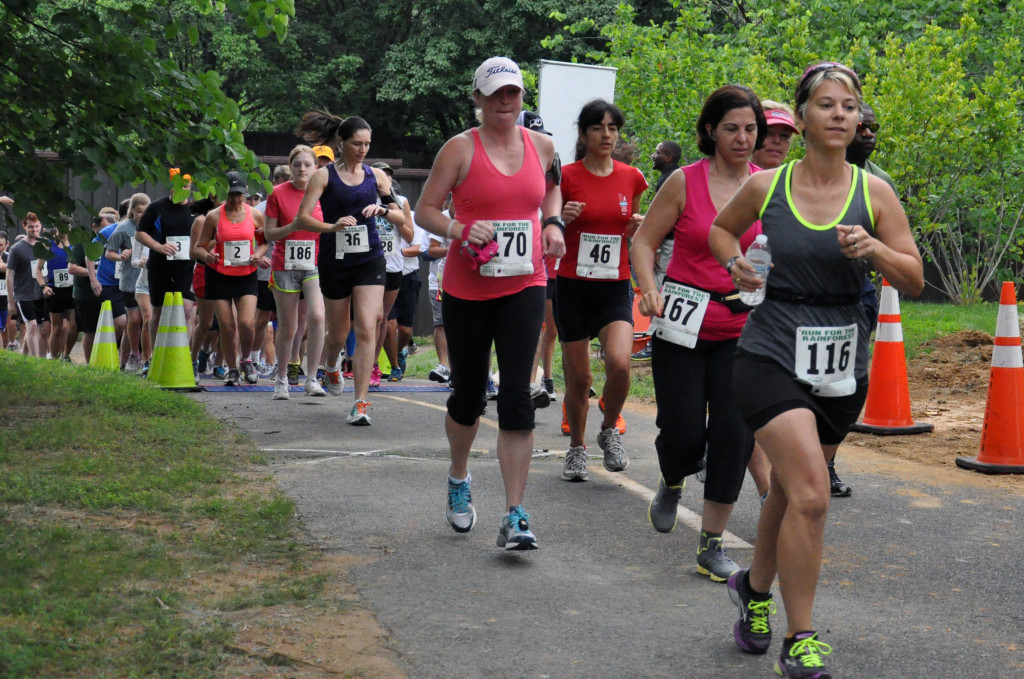
The Run for the Rainforest 5k in Arlington, Va., not only benefited the rainforest, but also felt like one as it drizzled and then poured on Sunday morning.
About 150 people finished the annual race put on by the Amazon Conservation Team on a mild morning hovering around 72 degrees. The race on a USATF-certified course began at 8 a.m. [button-red url=”http://www.runwashington.com/RAIN_5K_RESULTS.TXT” target=”_self” position=”left”] Results [/button-red]
The 3.1-mile loop course started on the Bluemont Junction Trail and continued onto the Washington and Old Dominion Trail before circling back and finishing at the Ballston campus of Marymount University. Runners lined up on the narrow running path in a light drizzle, but the sky opened up almost as soon as they’d crossed the start line.
Andy Stepka, a 17-year-old who runs cross country and track year round at Paul VI Catholic High School in Fairfax City, Va., took the top spot in the race, barely edging out 15-year-old Ryan Lesmez in a very close finish. Lesmez had the lead around the final corner when Stepka picked up the pace, sprinting the last 100 meters and beating Lesmez by just a foot-length.
Both men were listed as having an official finishing time of 18:25.
“I was coming around the corner, and I thought we’d have to make another loop, but I saw the finish line and decided to give it my all and try to slip past [Lesmez],” Stepka said.
Lesmez said he didn’t realize someone was that close behind him.
“I didn’t take this race as seriously as I could and decided not the sprint the end,” Lesmez said, who runs at Yorktown High School in Arlington.
In addition to the race preparing him for cross country in the fall, Stepka used the race as part of his training for the New Balance Falmouth Road Race, a 7-mile race on Cape Cod, Mass., on August 11. Lesmez is planning to do another run locally in August with friends, but has not decided which one.
Dominique Lee, a 25-year-old from Alexandria, was the first woman to cross the finish line in 22:59.
“It was an interesting race. I was alone for a lot of it, so that was tough, especially with all the rain and the last half was all uphill,” she said.
Lee ran in college, but took a few years off after and is just now easing back into distance running. The Rhode Island native’s next race will be the Blessing of the Fleet 10 Miler in Narragansett, R. I. on July 26. She used Saturday’s 5K to gauge where she was in her preparations for the longer race, but has no plans for any other local races.
She is also training for the Amica Marathon in Newport, R.I. this fall.
There were cash prizes for the top three male and female finishers, and raffle prizes available to all.
Finishers passed through a soggy balloon-lined fence while music blared, splashing through rivers of water on the street. Many were sporting the white technical t-shirt given to all participants, which featured the race logo: an image of a foot made up of blue and green leaves. While everyone running was soaked through head to toe, some didn’t seem to mind the wet weather.
“It was so hot, I love the rain. It felt good while I was running,” said Janet Garber, a 60-year-old from Alexandria.
Garber did the race with her two friends, Saleena Ross, a 59-year-old from Fort Washington, and Rita Cronley, a 59-year-old from Arlington. The three often race locally, and said they picked this race because it was the right time, place and distance for them.
Cronley said she likes to switch it up, taking on both small, local races as well as larger ones with a much bigger field size. For her needs now, the Run for the Rainforest 5K seemed like a good fit.
“I’m recovering from an injury, so I could take it easy,” Cronley said. “It was the perfect size and well-marked.”
Garber, who recently turned 60, said she was excited to “capitalize on a new age group.”
While some were just racing for fun, others picked the race because of the cause it supported. The goal of the Amazon Conservation Team is to empower indigenous people in the Amazon with the skills to better monitor and protect the rainforest. The money raised in the annual race is used to increase awareness about how important it is to save the rainforest, the race’s website said.
Evan Notman, a 47-year-old from Takoma Park, Md., was drawn to the race because he’s passionate about saving the environment and had heard of the organization putting on the race.
“In addition to protecting the rainforest, the Amazon Conservation Team does a lot of work helping indigenous people, which is very important,” Notman said.
Isabelle Anderson, a 10-year-old who ran the race with her dad, Angus, is another nature enthusiast drawn to the race for the good cause it supports.
She has participated in Girls on the Run at Rosehill Elementary School in Alexandria, but couldn’t this year because of a scheduling conflict, her father said. The two decided to find a 5K to do together as a replacement.
“I love nature and I like to run, so I thought it would be fun,” she said.


